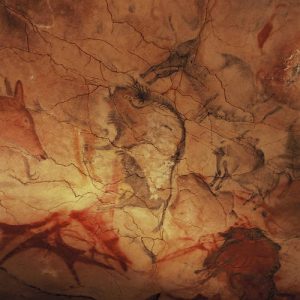The "Reading the World: Tablet to Tablet" exhibit has sparked our interested in cave art this week at the Mandeville Branch. While touring the exhibit, don't forget to stop by the activity table at the front of the branch where you can create your own cave art!
Even before the stone tablets of Sumeria, opens a new window, civilizations used cave walls as canvases and documented great hunts, rituals, and events important to the society that created them. Some of the most famous cave paintings, opens a new window are in France and Northern Spain, but paintings have been found in Africa, Indonesia, opens a new window, Russia, the Middle East, Mexico, and Australia.
Many people are familiar with cave paintings featuring stampeding bison or hand prints, but until recently little attention has been paid to the geometric markings around the images. However, paleoanthropologist Genevieve von Petzinger, a National Geographic Emerging Explorer, has conducted a new study of the signs. In her book, The First Signs, von Petzinger reports that Ice Age Europeans used just 32 distinct types of geometric symbols over a period of 30,000 years, suggesting that the markings were “meant to transmit information” and were an early step in mankind's journey to create writing.
Want to learn more about cave paintings?The Bradshaw Foundation, opens a new window has a fantastic website documenting rock art around the world. Check out Cave of Forgotten Dreams, Werner Herzog's documentary about the Chauvet Cave, opens a new window in France, or The Cave Beneath the Sea, which includes photographs of the stunning underwater Cosquer Cave, opens a new window paintings near Marseilles.
Please Note: In order to bring you new and interesting titles, Hoopla content is updated monthly, and this title may not be available in the future. To find the latest titles, please visit Hoopla, opens a new window.





Add a comment to: Tablet to Tablet: Cave Art and Other Early Mediums